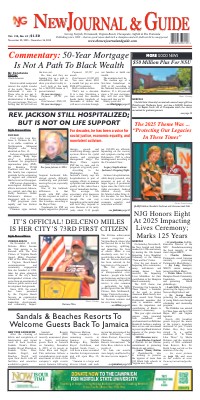National News
Katrina: 20 Years Later
Two decades after Hurricane Katrina devastated New Orleans, the city reflects on loss, survival, and resilience while confronting the lessons of government failure and the strength of community.
#Katrina20 #HurricaneKatrina #NewOrleans #ClimateChange #DisasterRelief #BlackCommunity #Resilience #NeverForget

By April Ryan
BLACK PRESS USA
Twenty years ago, George W. Bush was president of the United States, and Ray Nagin was the mayor of New Orleans when Hurricane Katrina barreled into the Gulf Coast, creating one of the worst natural disasters in the nation’s history.
“Today is a bittersweet day for the people of New Orleans. We lost 1,400 family members, friends, and neighbors … 250 homes and buildings. In an instant, we lost all that we held dear,” said Mitch Landrieu, the former Mayor of New Orleans from 2010 to 2018. For New Orleans, the storm’s force resulted in the levees breaking, which exposed deep issues in American society about addressing climate change, government, and infrastructure.
In 2005, it was a collision of a humanitarian crisis and governmental failure that left over 1,800 people dead in the Gulf Coast and more than a million residents displaced, making it one of the deadliest and most disruptive natural disasters in U.S. history. The Federal Emergency Management Agency (FEMA) was loudly criticized for its slow and disorganized response to the crisis. The Bush administration also received criticism for not moving swiftly, as it used states’ rights and the need for the state of Louisiana to formally ask for help instead of instinctively jumping in to provide needed assistance.
Mayor Nagin made many urgent requests for federal government help with rescue, recovery, and assistance for the displaced. The optics of the moment will never be forgotten: people stood on rooftops signaling helicopters for help as the water levels crested as high as the tops of houses.
The displaced, mostly Black hurricane victims, were also housed in the Superdome and the Convention Center of New Orleans in the aftermath of the levee break. During those frantic calls from the mayor, some network news media identified the Black displaced victims as “refugees.” An immediate response to that description came from rights groups like the NAACP, chastising the characterization of Americans seeking help.
The Ninth Ward of New Orleans was devastated. Today, many homes impacted right along the levee are no longer there, but you can still see the footprints of where some of the houses once stood. However, Landrieu exclusively told Black Press USA that for New Orleans, “with the help of each other, our neighbors and a helpful nation, we got up, dusted off, and rebuilt a great American city. For that, we will be forever grateful.”
New Orleans has rebounded today, with many of its residents returning to the Big Easy, ripe with flavor and culture. However, tourism in the city has dropped, particularly international tourism, due to the Trump administration’s current foreign policy stance.


 Black Business News1 week ago
Black Business News1 week agoBeyoncé Enters Billionaire Ranks Few Black Americans Have Reached

 Black History1 week ago
Black History1 week agoEmancipation Observances Began In 1863 Norfolk & S.C.

 Impacting Lives7 days ago
Impacting Lives7 days agoUtility Costs Are Rising Nationwide, Including Virginia

 Black Arts and Culture1 day ago
Black Arts and Culture1 day agoCelebrating Imani For Kwanzaa In Hampton Roads

 Black Business News2 days ago
Black Business News2 days agoBlack America’s Cultural Icons Whom We Lost in 2025

 Black Business News2 days ago
Black Business News2 days agoOur Path Forward To 2027

 Black History6 days ago
Black History6 days agoHonoring a Hero Instead of a Traitor

 Entertainment2 days ago
Entertainment2 days agoBridge Corner: The American Bridge Association (ABA)



















